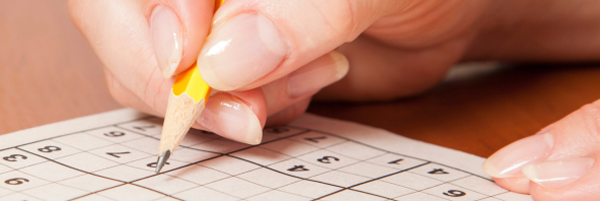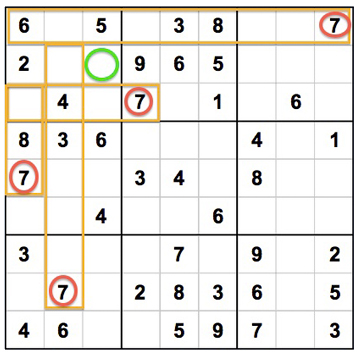How to Solve Sudoku Puzzles from Multiple Directions at Once

Look for Recurring Numbers
One of the best ways to spot patterns and opportunities in Sudoku is to look for recurring numbers – which numbers are already showing up on the grid? Which numbers are already visible on each row, column and square? Sometimes you can quickly eliminate a lot of empty spaces just by noticing which numbers are already ruled out.
For example, in this screen shot (shown below), there are several instances of the number 7. We can quickly realize that because of the placement of the four number 7s (circled in red), most of the empty spaces in the upper left square CANNOT contain 7s.

See the outlined spaces in orange – 4 out of the 5 spaces in the upper left square are automatically eliminated from containing a 7, which means that only the right column, center row space (circled in green) can contain a number 7. We have looked at two different rows, two different columns and four different squares to get the clues needed to eliminate the numbers from this single space.
Focus on One Space by Eliminating Multiple Numbers
Another way to solve Sudoku puzzles from “multiple directions” is to focus on one blank space where multiple numbers converge and can be eliminated. For example, in the following screenshot, the far right column (outlined in orange) has four blank spaces.

The numbers 1, 2, 3, 5 and 7 are already placed within the column, so we know that the four blank spaces must contain, in some combination, 4, 6, 8 and 9. The right center square contains numbers 4 and 8 (circled in red), so we know that those two numbers cannot appear in either of the blank spaces within that same right center square. When we look to the left, we can also see a number 6 (circled in red) in the bottom row of the center square.
By process of elimination, we know that there are only four empty spaces in the far right column, and we’ve ruled out 3 of the possible numbers for that lower right corner of the right-center square (circled in green) – so that means the green-circled space has to contain the number 9.
Sudoku beginners often look for the “low hanging fruit” and easy solutions to Sudoku puzzles, but once you learn the basic tricks, you can start looking at the grid with an eye for spotting opportunities from multiple angles. The whole Sudoku grid will open itself up and it will become faster and easier to solve Sudoku puzzles if you know how to broaden your view of the game.